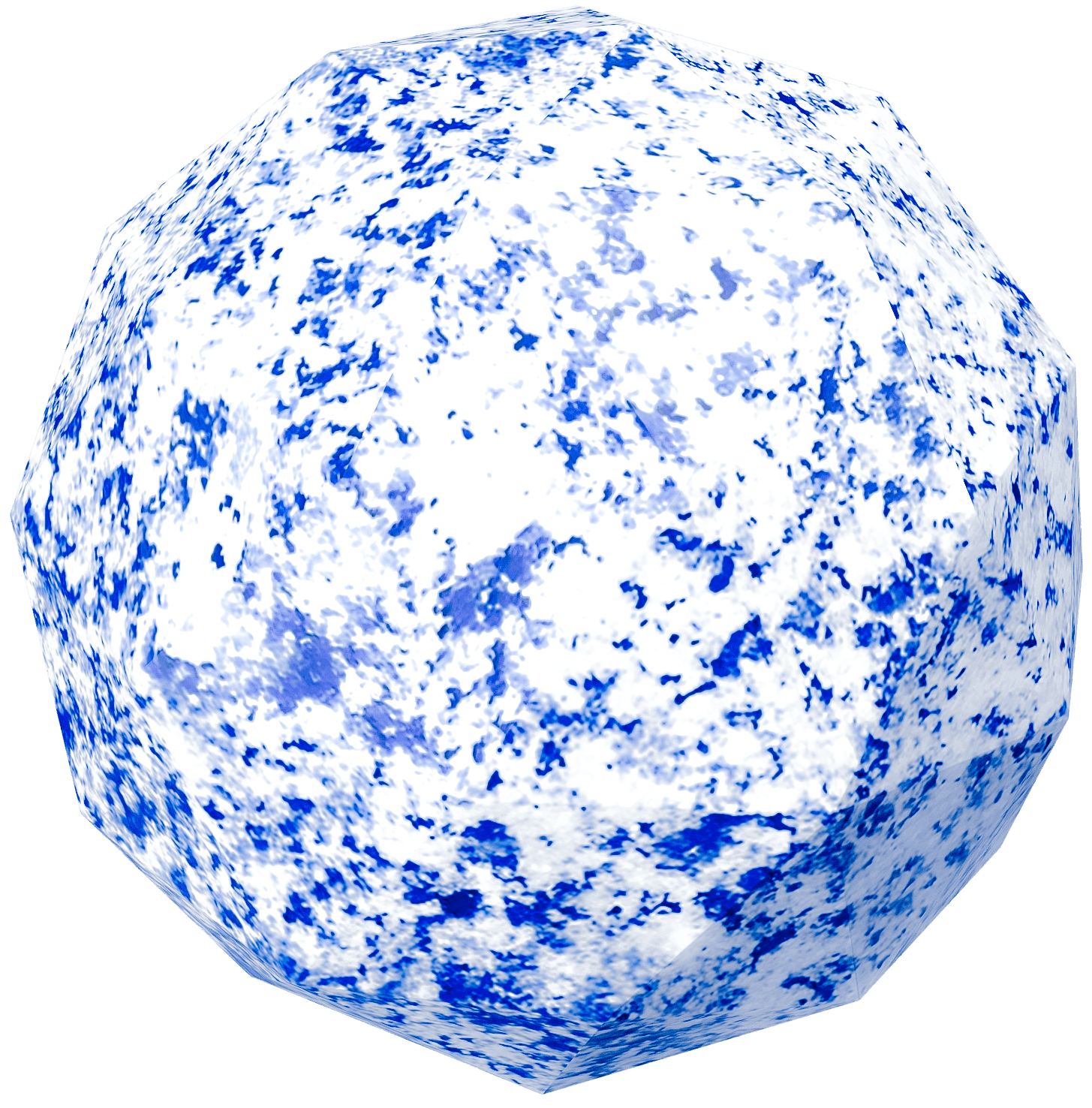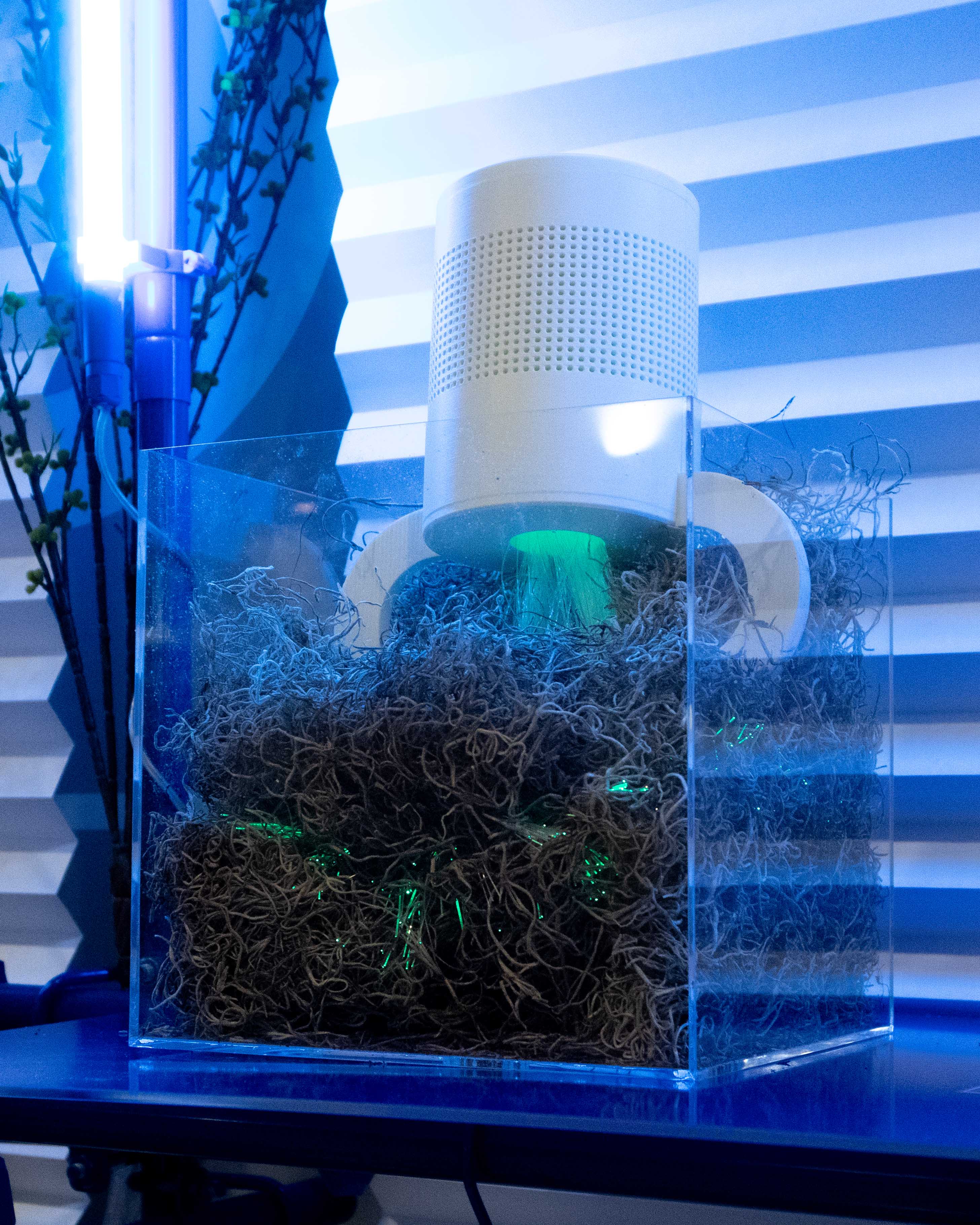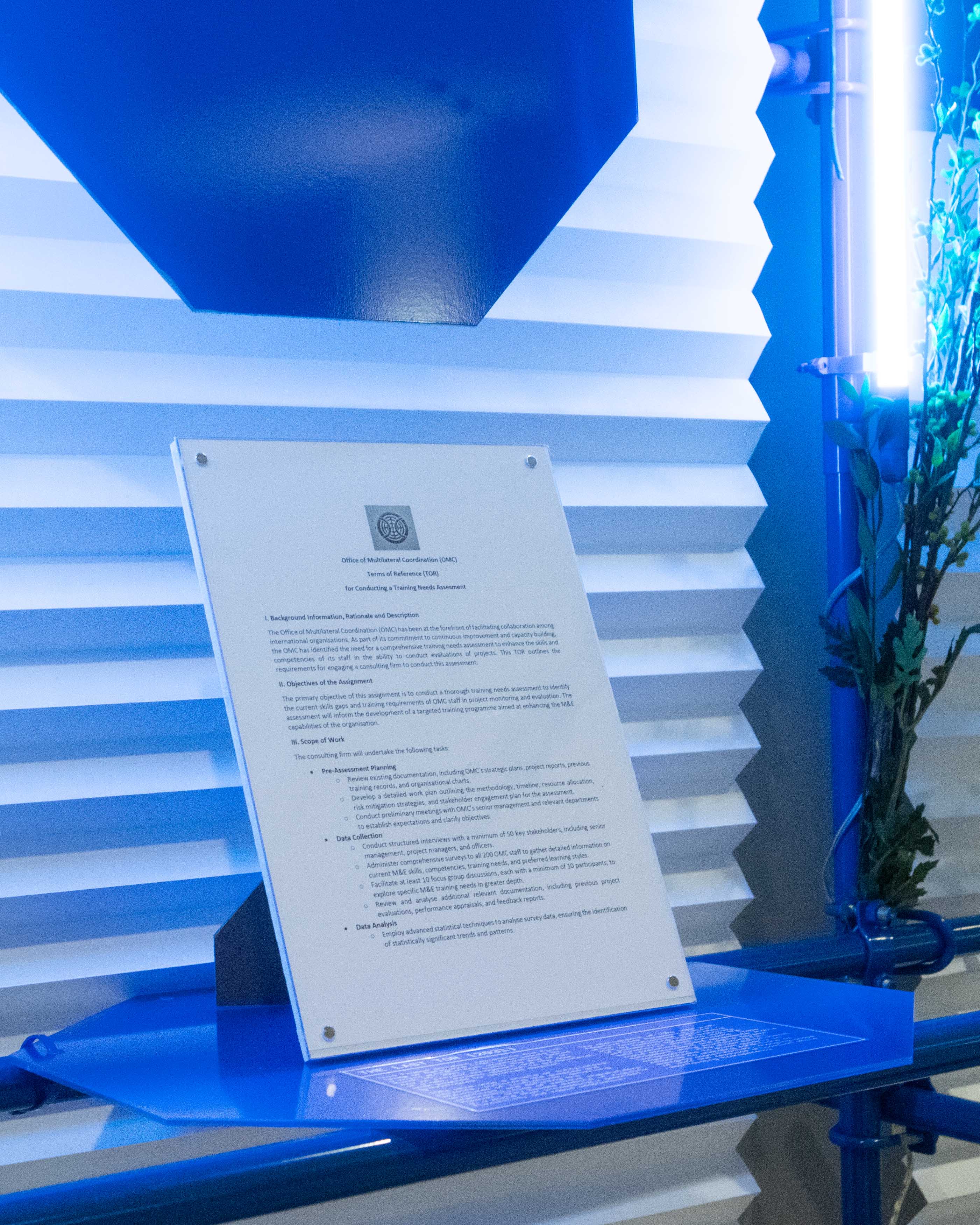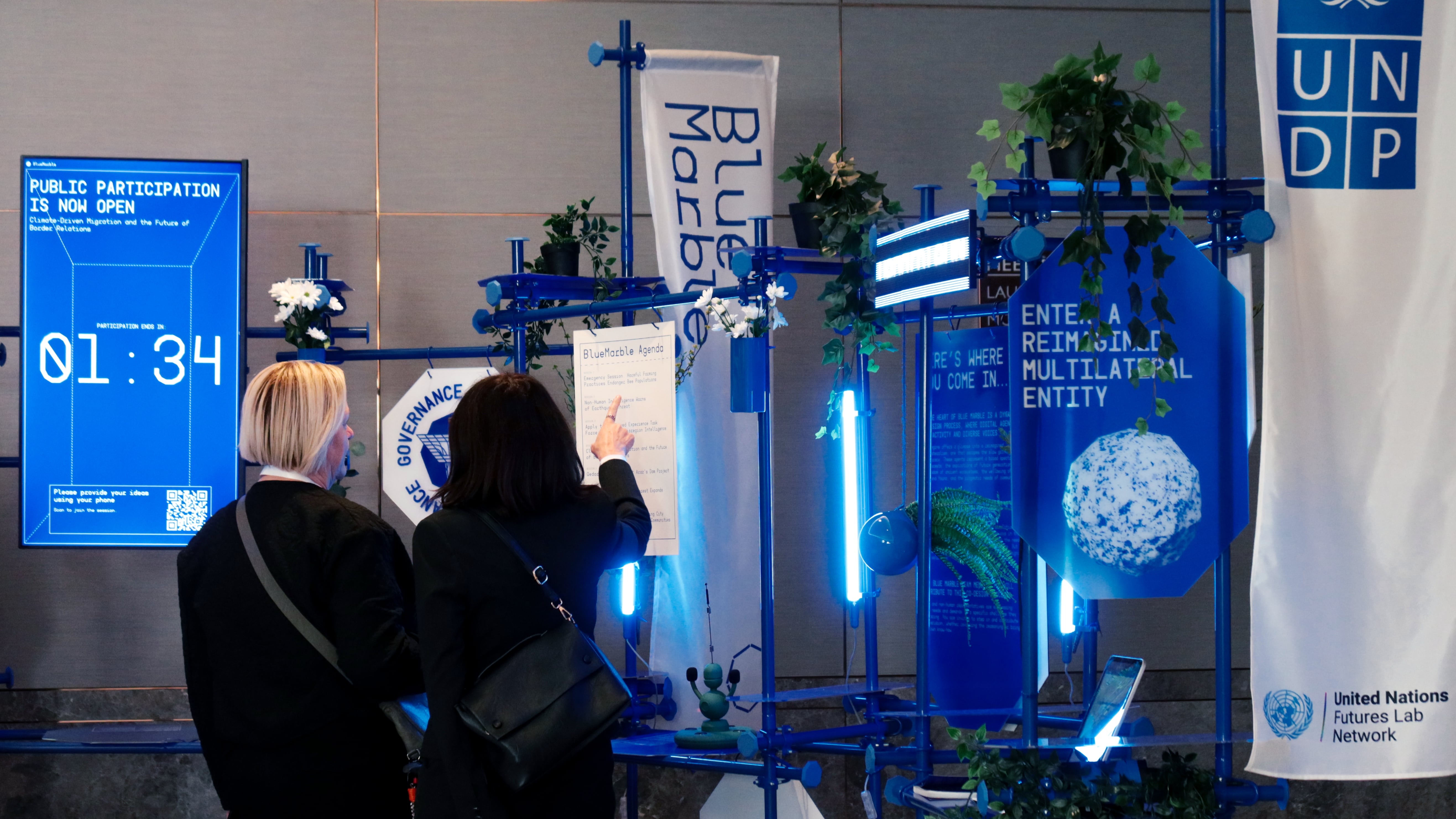MULTI-SPECIES' INTERESTS STEER ACTIONS
Blue Marble creates spaces for collective and inclusive decisions driven by agency and intelligence across species and generations.
BlueMarble

Multi Species Intelligence

At some point, we (finally) accepted that human intelligence alone is brittle and leaves us, humans, blindsided to possibilities. We acknowledged that what is happening in the natural world is far more computationally efficient, inventive & resilient than anything we could create from silicon. We accepted that what nature knows & does is far superior to what we, as a single species on this Planet, are capable of. We understood that we can no longer afford to go at this alone and that we also shouldn't.
So, the question becomes: What can we do with these new forms of intelligence? Can the multiplicity of 'knowing' embodied in plants and soil, oceans and animals, together with our own, usher in a new era on the Planet—multi-species collaboration that optimizes for regeneration, justice, well-being, and trust? This is a mandate of Blue Marble.
April 22th, 2030
MULTI-SPECIES' INTERESTS STEER ACTIONS
Blue Marble creates spaces for collective and inclusive decisions driven by agency and intelligence across species and generations.
Shifting power and decisions to those closest to opportunities and problems to build resilience and fairness across generations.
Imagine a world where ecosystems, not just human nations, had a voice in global decision-making. What if the Amazon rainforest, the Arctic ice caps, or the Great Barrier Reef sat in international forums, advocating for its needs and interests alongside those of human societies? What if natural entities had bank accounts and could invest in development? magine the Amazon rainforest receiving financial & non financial compensation for the carbon it sequesters, or coral reefs earning dividends from sustainable tourism?I How would this fundamentally shift our approach to climate change, biodiversity loss, and the sustainable management of our planet's resources?
What if future generations, those who will inherit the consequences of our choices today, had a say in shaping our present actions? What if we could understand a multiplicity of languages not just across different species but generations past and future? Imagine a multilateral system that incorporated the interests and perspectives of those yet to be born, ensuring that their voices are heard and their rights are protected.
Imagine a world where (financial) returns weren't measured in dollars and cents, but in the health and vitality of our planet. What new power dynamics would emerge if profitability of (social, natural, political, infrastructural, financial) investments hinged on impact on clean air, fresh water, thriving ecosystems, and a stable climate?

The Multi-Language Inter-species Interpreter (MLII), introduced in 2036, enables humans to communicate with animals and plants by translating their unique languages into human languages. Actors now have the ability to consult animals and plants and recognize their dignity in communicating their own interests.
The MLII utilizes advanced data processing and machine learning to analyze communication and behavior patterns from a wide range of species. It integrates research on species-specific communication methods, including:
The system considers contextual information such as environmental conditions and apparent emotional states to provide a nuanced interpretation of animal and plant responses to their surroundings.
The MLII has enabled more tailored and effective conservation efforts, facilitated negotiation over space usage with animals, learning from interviewing animals and plants has led to more wildlife-friendly cities.
GLOBAL FINANCE DRIVEN BY THE HEALTH INDEX OF THE PLANET
Blue Marble is built on a finance system that operates with planetary health at the center.
From a financial system that creates negative externalities to one where financial decisions are contingent on enhancing Earth's life-supporting systems, recalibrating economic imbalances.
Imagine a world where the flow of multilateral finance was as dynamic and responsive as the internet, guided by the real-time pulse and intelligence of planetary health and human well-being. What if past injustices, present actions, and future needs were synthesized into a constantly evolving equation, triggering immediate adjustments to the distribution of resources? At the heart of this system is the "Financial Router" - an intelligent device that redirects investments, rewarding those who protect the planet while invoicing those who contribute to its degradation. This creates a global network of incentives and consequences that accelerates our transition to a more just and sustainable future.
Consider a world where nations could secure funding for development, not based on their economic potential, but on their commitment to fostering the well-being of their citizens. What if "Return on Inspiration" and "Gross National Wellbeing Growth" were as important as traditional financial metrics, driving a more holistic and humane approach to global cooperation?
Imagine if development wasn't solely reliant on financial aid and investment, but harnessed the power & know-how of thriving ecosystems, local expertise, and social capital for change. Communities could take a leading role in investing in their own development through financial instruments such as “Civic Shares” backed by future gains in property & wellbeing value of the place they inhabit. Hybrid capital funds could contain unused space licensed by residents and people contributing their social capital and labor. Instead of investment profits extracted and concentrated in the hands of a few, they would circulate within communities, creating a virtuous cycle of shared prosperity.

The Uncertainty Fund is driven by the Planetary Health Index (PHI): a comprehensive metric developed collaboratively by scientists, indigenous communities, and data analysts that offers real time insights into the health check of the Planet and its constituents.
The PHI assesses nations' & companies' ecological footprint by considering historical actions, current practices, and the needs of future generations. On this basis it issues warnings to companies and countries whose actions seek to destabilize the PHI or compels them to settle a 'bill' that compensates for those actions should they still take place. Conversely, the Fund issues payouts to entities whose actions nurture the PHI.
The Fund's Balance Sheet illustrates each entity's overall net contribution to planetary health within the Aaru Bioregion. It also shows the Fund's latest actions triggered by the ecosystem damage, with automatic disbursements in cases of flooding, earthquake impact, local diseases and pests, mass habitat destruction, and food insecurity.
Unlike traditional insurance models, this global mechanism pools resources to protect against unpredictable future challenges, recognizing that old systems of global cooperation are too slow and outdated to effectively address today's interconnected crises.

This unassuming device revolutionized international funding and financial transparency in the mid-2030s. The Financial Router enabled real-time auditing and rule-based fund distribution, shifting control away from 'northern & developed' countries. Just as a data router manages the flow of information packets across a network, the Financial Router directs and oversees the flow of funds, ensuring they reach their intended destinations efficiently and transparently.
The Financial Router marked the end of year-end audits and donor-driven spending decisions. Instead, pre-agreed rules governed fund distribution, increasing autonomy for recipient countries while maintaining transparency. This innovation helped free multilateral actors from the whims of funders and alleviated longstanding power imbalances in North-South financial flows.
The Financial Router was designed as an independent physical device as a security measure against tampering or hacking attempts. This artifact represents a pivotal moment in reimagining global financial systems, aligning them with principles of equity, transparency and shared decision-making.
MOBILIZE COLLECTIVE INTELLIGENCE & AGENCY
Blue Marble harnesses real-time planetary health data and integrates diverse forms of multi-species & nature's know-how & 'capital' to drive change.
From a centralized international cooperation system to one that synthesizes intelligence from across different constituents, times, critical Earth systems and species to generate new choices for action.
Imagine the multilateral system not as a rigid, hierarchical structure, but as a decentralized, interconnected network, similar to the mycelium that supports vast forest ecosystems. What if it could sense emerging needs and rapidly reallocate resources to where they are most needed, responding as fast as a stock market to crises, opportunities, and unforeseen events? Instead of fixed budgets and rigid programs, funds would go to the most urgent needs, and the most effective agents of change in microseconds, based on real-time data that integrates human, non human & artificial intelligence .
These "Earthshots" would be transformative climate projects of unprecedented scale, such as building undersea infrastructure to preserve glaciers, continent-spanning green energy grids, or removing massive amounts of CO2 from the atmosphere. They would constitute a global response matching the scale and urgency of the climate crisis. Each Earthshot would demand the combined innovation, funding, and determination of multiple countries working in concert - think of a Global Climate Corps to which countries would contribute scientific, engineering, and managerial talent.
Open-source initiatives thrive on boundaryless collaboration, creating solutions greater than any individual could achieve alone. Imagine if multilateral institutions embraced this ethos, transforming into dynamic platforms where anyone, anywhere could contribute their ideas, skills, and resources to solving global challenges. What if we extended this collaborative approach to include not just human minds, but the intelligence of nature itself? Instead of energy-hungry artificial intelligence, could we develop computing networks powered by the collective intelligence of slime molds or coral reefs? Encoding data into seaweed and creating carbon-negative data centers that you can grow in your garden?

A fusion of biotechnology and environmental monitoring, the Mycelium Network Interface (MNI) allows humans to tap into nature's own communication and intelligence networks. It functions as both an advanced sensor network and an organic artificial intelligence system.
The MNI's sensor array, with its thin, wire-like tendrils, extends into the soil, interfacing directly with vast underground fungal networks often called "nature's internet". These mycelial threads, connecting various plants and trees, carry chemical and electrical signals that the device interprets. As a sensor network, it gathers real-time data on forest health, soil conditions, and ecosystem dynamics.
Simultaneously, the MNI harnesses these fungal networks as a living supercomputer. Its central processing unit not only translates environmental data but also utilizes the distributed intelligence of the ecosystem to solve complex problems related to climate modeling, resource allocation, and biodiversity management. This organic AI approach revolutionizes our understanding of ecosystem resilience and our approach to environmental stewardship, creating a system that both listens to and learns from nature's own networks.

This framed document represents the final Terms of Reference (TOR) ever issued by a major multilateral organization. Dated March 15, 2031, it marks the end of an era in project management and the dawn of a new, dynamic approach to multilateral work powered by advanced digital technologies.
TORs were once a staple of multilateral projects, outlining the purpose and structures of initiatives, detailing objectives, and defining the responsibilities of various stakeholders. However, they became symbols of rigidity in a world that increasingly demanded flexibility and rapid adaptation.
The abolishment of TORs came with Adaptive Code Agreements (ACAs), which revolutionized multilateral work by combining the flexibility of parametric agreements with the efficiency of smart contracts. These self-executing, coded agreements enable rapid procurement and agile project management while maintaining full transparency. ACAs allow multilateral organizations to pivot quickly in response to changing conditions or emerging opportunities, changing scope of work and resource allocation while maintaining transparency.

Blue Marble, is a speculative exhibition that imagines an international cooperation entity of the future whose mandate is safeguarding the health of the Planet and all its species.
Blue Marble is a travel exhibition and it will evolve after it is showcased in each place. It was already present in:
If you are interested in bringing Blue Marble to an event, please contact us to simone.uriartt@undp.org or to parima.suwannakarn@undp.org
Blue Marble is an interactive exhibition, in which visitors can experience how decisions are made differently.
The Aaru Bioregion comprises three countries sharing the Aaru River, each facing significant challenges:
Can a new multilateral approach foster cooperation before this cross-border mix of climate change, water insecurity, and conflict escalates into chaos?
At the heart of Blue Marble is a dynamic 'co-design' process, where digital agents hum with diverse voices of both human and nonhumans.
This co-design process operates at a speed far beyond human capabilities.
As a Blue Marble team member, you will contribute to this co-design process.
About
The world's biggest challenges—conflicts, inequality, and climate disasters—are outpacing our ability to respond effectively. Global institutions are falling short in addressing these pressing issues.

A thriving future is predicated on our ability to remodel multilateralism. Traditional models of global cooperation predicated for more stable and predictable environments are inadequate to deal with multiple overlapping crises that define our present. They fail to orchestrate intelligence across different sectors, disciplines & entities to come up with new responses for multi dimensional issues.
We need to envision different futures for our multilateral institutions.
Blue Marble is a provocation - an invitation to step into an alternate future of global cooperation. In this space. What could a different kind of global cooperation look like? What new logics would drive it? What would you want it to look like and what do we need it to be?
The Blue Marble stretches existing signals of change into imagination of what new forms of multilateral system could look like.Its mandate rests on the concept of generative intelligence - synthesizing knowledge across human and non-human species to constantly produce new responses to emerging opportunities and challenges to regenerate societies of species, environment and politics. It is one of many possible answers about how we could transform multilateral cooperation.
To build a different future, we must first imagine it.
Acknowledgements
Blue Marble is a collaboration between the UNDP Strategic Innovation Unit and the UN Futures Lab, with special guidance from the UNDP Strategy & Futures Team.


Thanks to the government of Denmark for a decade-long investment in UNDP's innovation work.
The Blue Marble Exhibition will be featured at the Istanbul Innovation Days (IID) 2025, exploring emerging directions in institutional innovation (collaboration with the Institutional Architecture Lab). The IID is a collaboration between UNDP and the Government of the Republic of Türkiye.
Experiential Design: Henrique Nascimento, Joao Delgado, Kal Joffres, Parima Suwannakarn, Simone Uriartt, Tiago Nunes.
Content: Ida Uusikyla, Kal Joffres, Marco Steinberg, Milica Begovic, Parima Suwannakarn, Simone Uriartt, Xoan Garcia.
With inspiration from: Alexandra Bekker, Alexandru Oprunenco, Alberto Cottica, Darah Aljoudar, Deborah Naatujuna, Edo Stork, Francine Pickup, Geoff Mulgan, Giulio Quaggiotto, Indy Johar, James Bridle, Jayne Engle, Jennifer Colville, Jessica Seddon, John Moore, Julia Caon Froeder, Kamila Camilo, Kawtar Zerouali, Keolu Fox, Lejla Sadiku, Leon Seefeld, Liam Young, Luciana Mermet, Maria Suokko, Narue Shiki, Nalubaaga Valley Community, Oli Bremmer, Paula Carramaschi Gabriel, Sally Adee, Samantha Power, Vanessa Howe-Jones, Nina Strandberg.
